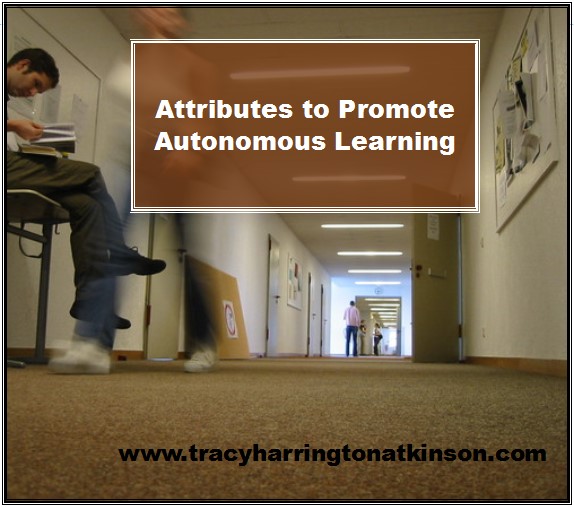
by Tracy Harrington Atkinson
Ponton & Carr (2000) lay foundational research determining the underlying attributes of autonomous learning. These characteristics include initiative, resourcefulness and persistence which are essential to the successful acquisition of knowledge in any learning environment. Students who possess autonomous learner characteristics also demonstrate greater intrinsic motivation than their counterparts (Salinas, Kane-Johnson & Vasil-Miller, 2008; Smith & Cardaciotto, 2011). Additionally, when these students are introduced to learner centered instructional methods, they construct their own meanings, develop more complex projects than students in traditional sections who are taught through lecture methods and the level of mastery increased (Hawai, 2010).
Learning Environment
Knowles (1975) proposed that within the formal classroom, self-directed learning situations require a particular type of environment. He called it a warm learning climate. Such a warm learning climate possesses mutual respect for individual experience and creativity shaping a “warm, mutually respectful, dialogic and mutually trustful” (p. 29) environment. It is conducive to communication where participants may be actively involved.
Teachers need to motivate students to pursue self-directed learning principles to acquire a lifelong learning desire. As a result these tools move the learning from needing extrinsic motivation to relying on intrinsic motivation. This type of motivation helps the learner move from being a reactive recipient of knowledge to a proactive procurer for information. Autonomous learners demonstrate a greater awareness of themselves and their responsibility to contribute to their society and community (Gibbons, 2011).
Technology and Learner Centered Instruction
Reinders & White (2011) delve into the possibilities of using technology in assessing the autonomous learner. Technology can be used to achieve some educational goals such as developing the characteristics of learner autonomy as students are given the opportunity to feel empowered in their own learning experience. Researchers noted an additional quality of autonomous learners being about interdependence and less about independence as previously perceived. The weaknesses of technology are evident in the constraints it places upon learners as it can create a sense of over-dependence and even a false sense of development.
Arikan and Bakla (2011), however, used technology to promote learner independence, creating opportunities for learner centered instruction. Their research demonstrated an efficiency and desire for autonomous learners to involve critical reflection, learning strategies and computer skills in the development of characteristics which have been attributed to autonomous learners. Legenhausen (2011) also found that autonomous learning increased as student directed learning environments were made available.
Motivation and Academic Performance
Educators are those individuals who coach students to learn from failures and evolve into intrinsically motivated people. They recall that content is used not to simply assimilate information but to define learning skills as students are molded into passionate self-directed learners who are capable of determining their strengths and weaknesses (Weimer, 2002). Arikan and Bakla (2011) also found that many students resisted any activities that may require more effort and change of the locus of control over their learning environment.
Academic performance is closely associated with motivation. Ng, et. al. (2011) found four qualities associated between motivation and academic performance as determined through autonomous learners. These four qualities are desire, resourcefulness, initiative and persistence. Many of these autonomous learners possessed greater intrinsic motivation in direct relation with their academic performance.
Summary
As the student uses these characteristics, not only does the student’s cumulative GPA rise but greater educational and life opportunities present themselves. Pompper (2006) showed a direct correlation between students with characteristics of autonomous learning and student retention in higher education. Persistence, initiative and resourcefulness positively correlated with a student’s determination to pursue their higher education despite personal difficulties of family, finances and even personal transitional experiences such as a marriage or divorce.
Sources:
Arikan, A. & Bakla, A. (2011). Learner autonomy online: stories from a blogging experience. In D. Gardner (Ed.) Fostering autonomy in language learning (pp. 240-251). Gaziantep: Zirve University.
Gibbons, M. (2011). Motivating students and teaching them to motivate themselves. Retrieved from www.selfdirectedlearning.com/article2.html
Knowles, M. (1975). Self-directed learning: a guide for learners and teachers. Parsippany, New Jersey: Globe Fearon Press.
Legenhausen, L. (2011). The place of grammar in an autonomous classroom: issues and research results. In D. Gardner (Ed.) Fostering autonomy in language learning (pp. 27-38). Gaziantep: Zirve University.
Ng, S., Confessore, G., Yusoff, Z., Aziz, N., & Lajis, N. (2011). Learner autonomy and academic performance among undergraduate students. International Journal of Social Sciences and Education, 1(4), 669-679.
Pompper, D. (2006). Toward a relationship-based approach to student retention in higher education. Public Relations Quarterly, 51(2), 29-36.
Ponton, M. & Carr, P. (2000). Understanding and promoting autonomy in self-directed learning. Current Research in Social Psychology, 5(19), 34-46
Salinas, M., Kane-Johnson, S. E. & Vasil-Miller, M. A. (2008). Long-term learning, achievement tests and learner centered instruction. Journal of the Scholarship of Teaching and Learning, 8(3), 20-28.
Smith, C. V. & Cardaciotto, L. (2011). Is active learning like broccoli? Student perceptions of active learning in large lecture classes. Journal of the Scholarship of Teaching and Learning, 11(1), 53-61.
Weimer, M. (2002). Learner centered teaching: five key changes to practice. San Francisco, California: Jossey Bass.
By Tracy Harrington-Atkinson
Tracy Harrington-Atkinson, mother of six, lives in the Midwest with her husband. She is a teacher, having taught elementary school to higher education, holding degrees in elementary education, a master’s in higher education and continued on to a PhD in curriculum design. She has published several titles, including Calais: The Annals of the Hidden, Rachel’s 8 and Securing Your Tent. She is currently working on a non-fiction text exploring the attributes of self-directed learners: The Five Characteristics of Self-directed Learners.

Comments are closed